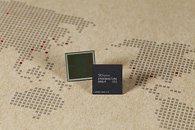- Joined
- Dec 6, 2011
- Messages
- 4,784 (0.98/day)
- Location
- Still on the East Side
SK Hynix Inc. announced that it has developed the world's first 8 Gb (Gigabit) LPDDR4 (Low Power DDR4) using its advanced 20 nm class technology. LPDDR4 is the next generation mobile DRAM interface on the process of standardization which features ultrahigh speed and low power consumption.
This new product works at 3200 Mbps and ultra low-voltage of 1.1V which runs two times faster than 1600 Mbps and does at lower voltage than 1.2V of existing LPDDR3. The Company has been strengthening its cooperation with the customers for the standardization of this new mobile DRAM by providing the samples of LPDDR4 to major customers and SoC(System on Chip) companies.

Especially, SK Hynix is to continuously maintain its technology leadership in the mobile market by developing the world's first 8 Gb LPDDR4 following the development of the world's first 8 Gb and 6 Gb LPDDR3. The Company plans to start mass production of it from the second half of next year.
"SK Hynix secured its technology leadership by developing the world's first next generation mobile memory LPDDR4 and providing samples of the product to the customers" said Senior Vice President Richard Chin, the Head of Global Sales Marketing. "The Company will further strengthen its competitiveness in the mobile area with the development of high density, ultrahigh speed and low power consuming products" he added.
The new interface LPDDR4 is expected to be loaded onto flagship mobile devices at the end of 2014 and is anticipated to be commercialized regularly from 2015. Plus, it is expected to be the main product in the industry from 2016.
View at TechPowerUp Main Site
This new product works at 3200 Mbps and ultra low-voltage of 1.1V which runs two times faster than 1600 Mbps and does at lower voltage than 1.2V of existing LPDDR3. The Company has been strengthening its cooperation with the customers for the standardization of this new mobile DRAM by providing the samples of LPDDR4 to major customers and SoC(System on Chip) companies.

Especially, SK Hynix is to continuously maintain its technology leadership in the mobile market by developing the world's first 8 Gb LPDDR4 following the development of the world's first 8 Gb and 6 Gb LPDDR3. The Company plans to start mass production of it from the second half of next year.
"SK Hynix secured its technology leadership by developing the world's first next generation mobile memory LPDDR4 and providing samples of the product to the customers" said Senior Vice President Richard Chin, the Head of Global Sales Marketing. "The Company will further strengthen its competitiveness in the mobile area with the development of high density, ultrahigh speed and low power consuming products" he added.
The new interface LPDDR4 is expected to be loaded onto flagship mobile devices at the end of 2014 and is anticipated to be commercialized regularly from 2015. Plus, it is expected to be the main product in the industry from 2016.
View at TechPowerUp Main Site



